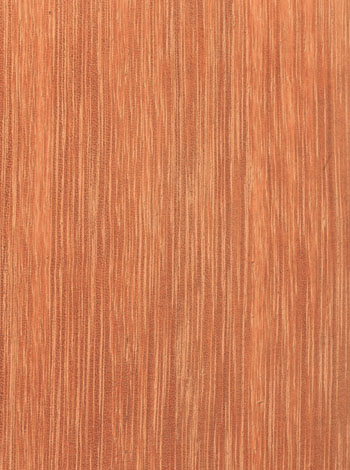| Introduction | The Standard Malaysian Name for the timber of Koompassia malaccensis (Leguminosae). Vernacular names applied include impas (Sabah) and menggris (Sarawak). This is a monospecific timber. The sapwood is white or pale yellow and is sharply defined from the heartwood, which is pinkish when fresh and darkens to bright orange-red or deep brown.
Also known as Kempas (Brunei); Hampas, Impas, Kempas, Keranji, Mengeris, Mengris, Pah and Upil (Indonesia); Koompassia (Papua New Guinea); and Makupa, Sifai and Tong-bueng (Thailand). |
| Botanical Name: | Koompassia spp. principally K. malaccensis, K. excelsa. Family: Leguminosae. |
| Natural Durability: | Based on the standard graveyard test of untreated specimens of dimension 51 mm x 51 mm x 610 mm, the wood is classified as moderately durable under the Malaysian condition. In a test conducted at the Forest Research Institute Malaysia (FRIM), the average service life for 161 untreated specimens was 2.5 years. The sapwood is very susceptible to both powder-post beetles and fungi attacks, while the heartwood is readily destroyed by termites. Kempas treated with the appropriate wood preservatives is very durable even under exposed condition. In an experiment, 40 test sticks (64 mm x 64 mm x 760 mm) with an average absorption of 224 kg/m3 (14 lb/ft3) of creosote were buried for the durability test. 25% of the specimens were destroyed after 35 years. |
| Uses: | The timber when treated with preservatives is suitable for all heavy constructional works, posts, beams, joists, rafters, piling, columns (heavy duty), fender supports, pallets (permanent and heavy duty), door and window frames and sills, tool handles (impact), bridges, wharves, marine construction, railway sleepers, telegraphic and power transmission posts and cross arms. When untreated, the timber is suitable for structures under cover, flooring, panelling, mouldings, vehicle bodies (framework and floor boards), plywood and charcoal manufacture. |
| Texture: | Texture is rather coarse but even except in areas where included phloem occurs. Grain is interlocked, often very interlocked. |
| Density: | The timber is a Medium Hardwood with a density of 770-1,120 kg/m3 air dry. It was reported that the material from Sabah and Sarawak is much denser than the material from Peninsular Malaysia. |
| Shrinkage: | Shrinkage is on the high side with radial shrinkage averaging 2% and tangential shrinkage averaging 3%. |
| Defect: | Though some borer damage have been recorded, the logs of freshly felled K. malaccensis are generally free from defects. The major defect that is associated with the timber of kempas is the presence of included phloem. Rings of included phloem often show up conspicuously at the cross-section of the log. In sawn timber, bands of included phloem extending longitudinally can often be seen on the radial surfaces. Patches of included phloem can also be seen on sawn timbers. These zones of abnormal tissue are hard and usually give rise to seasoning degrade and mechanical weakness in the timber. |

